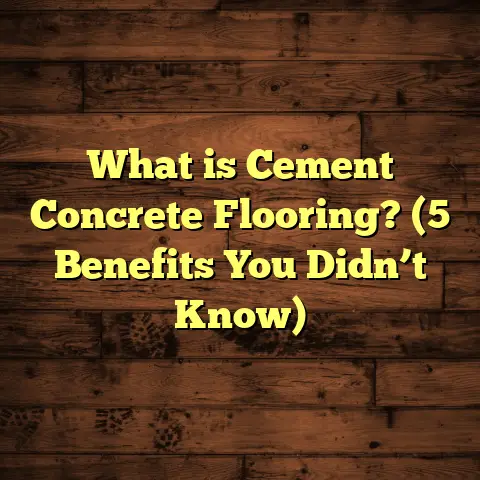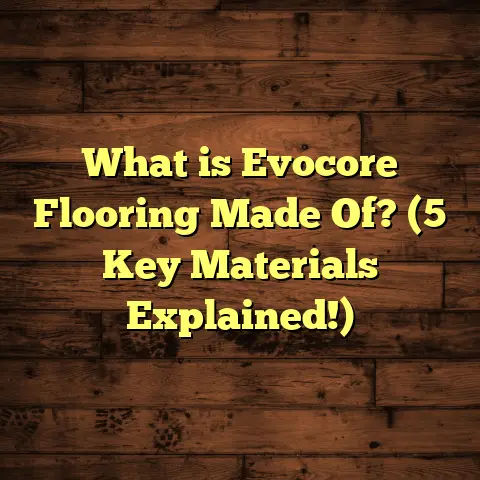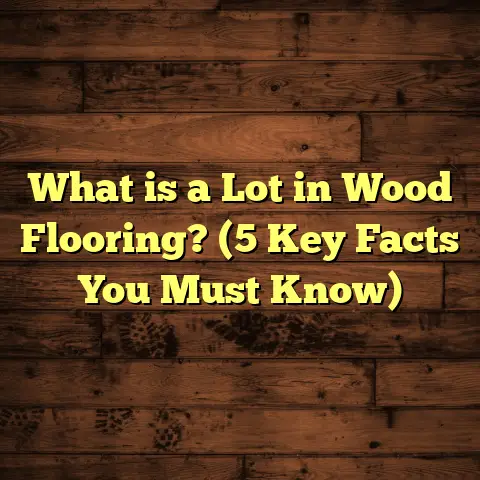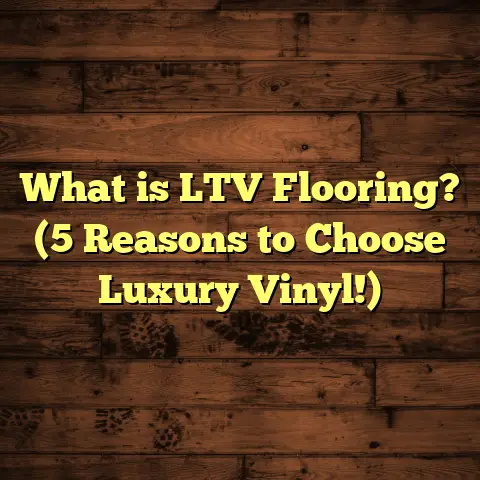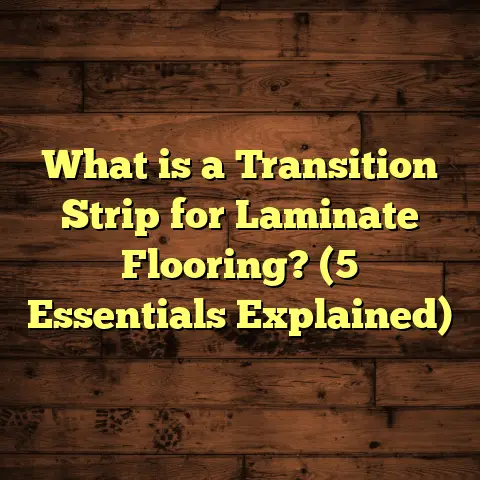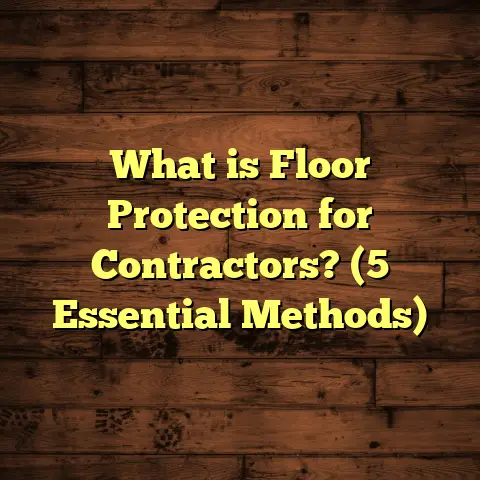What is Floor Covering? (5 Types You Must Know Today!)
Have you ever stood in the middle of a room wondering what kind of floor covering would be best? Maybe you’re renovating a home, or maybe you just want to upgrade your space without breaking the bank. If you’ve ever faced that decision, you know it’s not as simple as just picking a color or texture. There’s so much more to floor covering than meets the eye. Over years of working as a flooring contractor and helping friends and clients make the right choices, I’ve gathered quite a bit of knowledge. Now, I want to share everything I know about floor covering—what it is, why it matters, and the five types you really need to know about today.
What Is Floor Covering?
Let’s start with the basics: what is floor covering? At its core, floor covering refers to any material applied on top of a subfloor or floor structure to create a functional surface for walking, standing, and living. This surface has to protect the underlying structure, provide comfort, and ideally add style.
But it’s more than just the material itself. Floor covering includes how it’s installed, maintained, and how it performs over time. Think of it as the skin of your floor—the layer that interacts with daily life. Without proper floor covering, a subfloor would be exposed to damage from foot traffic, moisture, dirt, and other hazards.
Why Does Floor Covering Matter So Much?
When I first got into flooring, I quickly learned that many homeowners underestimate how much floor covering affects their daily life. It’s not just about looks; it’s about comfort, safety, durability, and even health.
For example:
- Comfort: Walking barefoot on hardwood feels completely different than on cold ceramic tile or plush carpet.
- Safety: Certain floor coverings reduce slips and trips—important if you have kids or elderly people around.
- Durability: Some materials hold up better in high-traffic areas or places with moisture.
- Maintenance: How much time do you want to spend cleaning? Different coverings require different care.
- Cost: Your budget can limit or expand your choices.
- Environmental Impact: Some materials are more eco-friendly than others.
In my early days as a flooring contractor, I had a client who chose vinyl for their kitchen because it was affordable and water-resistant. But they didn’t realize it wasn’t the easiest to repair when damaged. When their dog scratched the surface, they had to replace an entire section. That experience taught me how important it is to weigh all factors before choosing.
The 5 Essential Types of Floor Covering You Should Know
Over the years, I’ve worked with dozens of different floor coverings, but five types keep coming up as the most popular and practical for most homes and commercial spaces. Let’s explore them one by one:
1. Hardwood Flooring
Hardwood flooring is like the grandparent of floor coverings—classic, elegant, and incredibly durable. It’s made from solid wood planks harvested from trees like oak, maple, cherry, and walnut.
What Makes Hardwood Special?
The thing about hardwood is its natural beauty and longevity. When I installed hardwood floors during my first big residential project, I realized how much character those planks brought into a room. Each board tells a story with its grain patterns and color variations.
Here’s what I’ve found makes hardwood stand out:
- Longevity: Hardwood floors can last for generations if cared for properly.
- Refinishing: One of its biggest advantages is that you can sand and refinish hardwood floors multiple times to restore their original beauty.
- Value: According to the National Association of Realtors (NAR), homes with hardwood flooring sell faster and at a premium price—up to 5% more.
- Variety: Species like oak are hard and durable; cherry offers warm reddish tones; walnut gives a rich dark look.
Real Data on Hardwood Costs
When budgeting for hardwood installation, costs can vary widely based on wood species, plank width, finish type, and labor.
| Wood Type | Cost per Sq.Ft. (Material + Installation) |
|---|---|
| Red Oak | $6 – $10 |
| Maple | $7 – $11 |
| Walnut | $8 – $12 |
| Hickory | $7 – $13 |
And don’t forget the cost of finishing or refinishing down the road—around $3 per sq.ft., which adds years to your floor’s life.
My Hardwood Installation Experience
Once, on a large family home project with 2,500 sq.ft. of hardwood flooring, we spent nearly two weeks installing oak planks. The family wanted a classic look with matte finish to minimize glare from sunlight.
I remember the dad told me: “This is going to be the heart of our home.” Watching how this floor transformed their living space was rewarding. The floors still look amazing seven years later.
2. Laminate Flooring
Laminate flooring is often mistaken as just a budget alternative to hardwood but it has its own strengths that make it a smart choice in many situations.
What Is Laminate Flooring?
Laminate consists of fiberboard core layers topped with a photographic layer that realistically mimics wood or stone textures under a clear protective coating.
Here are some reasons why laminate is so popular:
- Affordability: Laminate typically costs between $1 and $5 per square foot including installation.
- Durability: It resists scratches and stains better than hardwood or carpet.
- Installation: Click-lock systems make it easy to install as a floating floor — great for DIYers.
- Maintenance: Requires little effort—just sweep or mop lightly.
When Does Laminate Make Sense?
I often recommend laminate for apartments or rental homes where owners want durability without spending heavily on hardwood. For example, I installed laminate in a young couple’s apartment that saw heavy foot traffic and pets—they loved how resilient it was after months of use.
What Do The Numbers Say?
A survey by HomeAdvisor shows average laminate floor lifespan between 10 to 20 years depending on maintenance and quality — not bad for an affordable option.
3. Vinyl Flooring (Including Luxury Vinyl)
Vinyl flooring has evolved tremendously in recent years. Once considered cheap and unattractive, vinyl now comes in high-quality versions like luxury vinyl planks (LVP) that convincingly imitate wood or stone.
Why Vinyl Stands Out
Vinyl’s main advantage is its water resistance combined with style options that appeal to many homeowners.
From my experience:
- Waterproof: Ideal for bathrooms, kitchens, basements.
- Comfortable: Softer underfoot than tile or hardwood.
- Easy Maintenance: Just sweep and mop.
- Cost-effective: Typically between $2 and $7 per sq.ft.
I installed LVP in an office break room last year where spills were common. The client loved how easy it was to clean up messes without worry about water damage.
Industry Trends & Data
Vinyl flooring sales have increased by over 20% in the past five years according to market research firm Freedonia Group. Its lifespan ranges from 10 to 20 years depending on traffic and quality.
4. Ceramic and Porcelain Tile
If you want durability plus design flexibility in wet areas like kitchens or bathrooms, tile is a contender that rarely goes out of style.
Why Choose Tile?
Tile floors are made from clay baked at high temperatures, glazed for color or texture (ceramic), or made denser and less porous (porcelain).
From my many tile installations:
- Waterproof & Durable: Tiles resist moisture and stains.
- Variety: You can find traditional terracotta tiles or modern geometric porcelain options.
- Easy Cleaning: Tiles resist odors and dirt buildup.
- Price Range: From $5 up to $15+ per square foot depending on tile type and labor complexity.
Tile Installation Insights
Tile installation requires skill—especially for patterns or large rooms. I’ve worked with teams where proper underlayment preparation prevented cracking or uneven surfaces years down the line.
The Tile Council of North America reports steady annual growth in tile sales due to rising demand for durable yet stylish flooring solutions.
5. Carpet Flooring
Carpet may seem old-school but it still holds value for comfort-focused spaces like bedrooms or family rooms.
What Makes Carpet Unique?
Carpet adds softness underfoot and warmth that hard floors can’t match. It also reduces noise—a big plus in multi-story homes.
From personal projects:
- I installed plush carpets in kids’ playrooms where safety and comfort were priorities.
- Carpet choices range from natural wool (more expensive but eco-friendly) to synthetic fibers like nylon or polyester (affordable and stain-resistant).
Cost & Lifespan
Carpet costs vary widely—from $2 to $7 per square foot including installation—with lifespan around 5-15 years depending on quality and use.
The Carpet & Rug Institute highlights carpet’s ability to reduce heating bills by up to 20% due to insulation properties in colder climates.
What About Installation Costs? How Do I Budget Smartly?
One question I get all the time is: “How much will this cost me?” And honestly, it depends on many factors—material choice, room size, labor rates in your area, prep work needed (like removing old flooring), delivery fees, waste allowances… the list goes on.
Early in my career, I would spend hours calling suppliers for quotes and doing manual calculations that sometimes missed important details like waste factor (extra material needed due to cuts or mistakes).
That’s why I started using FloorTally—a tool that helps me estimate realistic costs quickly by inputting local labor rates, material prices, room dimensions, and even waste percentages.
Here’s how FloorTally helps me:
- Saves time by consolidating all calculations into one platform.
- Gives me detailed cost breakdowns so clients understand exactly where money goes.
- Allows me to compare different types of flooring side-by-side within a budget.
- Helps me avoid ordering too little or too much material by factoring in waste.
Using this tool has made budgeting smoother for both me and my clients—and reduced surprises mid-project massively!
Comparing These Five Floor Coverings Side-by-Side
To help you visualize differences better, here’s a table summarizing key points:
| Feature | Hardwood | Laminate | Vinyl | Tile | Carpet |
|---|---|---|---|---|---|
| Durability | Very High | Medium | High | Very High | Medium |
| Water Resistance | Low | Low-Medium | High | Very High | Low |
| Cost per Sq.Ft. | $6 – $12 | $1 – $5 | $2 – $7 | $5 – $15 | $2 – $7 |
| Installation Ease | Moderate | Easy | Easy | Difficult | Easy |
| Maintenance | Moderate (refinishing) | Low | Low | Low | Moderate |
| Lifespan | 30 – 100 years | 10 – 20 years | 10 – 20 years | 25+ years | 5 – 15 years |
| Comfort Level | Medium | Medium | High | Low | Very High |
| Aesthetic Variety | High | High | High | Very High | Medium |
Personal Stories That Shaped My Flooring Advice
Let me share a few personal stories that gave me insights beyond textbooks or sales brochures:
Story #1: The Basement Disaster
A client wanted cheap laminate in their basement without realizing moisture could cause swelling damage over time. After just two years, several planks buckled badly due to humidity trapped underneath. From then on, I always recommend vinyl or tile for basements unless there’s a full waterproofing system installed.
Story #2: The Busy Family Kitchen
Another client chose hardwood for their kitchen because they loved the look but quickly regretted it after constant scratches from kids’ activities showed up within months. We ended up refinishing twice within five years but eventually switched areas prone to wear over to vinyl planks instead.
Story #3: The Cozy Nursery
When my sister was preparing her baby’s nursery, she wanted something soft and warm underfoot but easy on allergies. We chose low-pile carpet with hypoallergenic padding underneath. It created a safe play area while reducing noise from footsteps upstairs.
What Should You Ask Yourself Before Choosing Floor Covering?
Here are some questions I always ask clients (and myself) before deciding:
- How much foot traffic will this area get?
- Is moisture exposure likely? Bathrooms? Kitchens? Basements?
- How important is comfort vs durability?
- What’s my budget—including installation?
- Do I want something easy to clean?
- Am I sensitive/allergic to certain materials?
- How long do I expect these floors to last?
- Will I want to change floors again soon or keep them long-term?
Answering these helps narrow choices dramatically—and saves headaches later.
Final Thoughts
Floor covering might not be glamorous at first glance but it shapes how we live day-to-day. Whether you want luxurious hardwood warmth or practical vinyl resilience, knowing your options helps you get exactly what your space needs.
By sharing my experiences alongside real data and practical tools like FloorTally for cost planning, I hope you feel empowered to make thoughtful decisions that suit your lifestyle perfectly.
Still unsure about what fits your project? Just reach out—I’m happy to chat through options tailored just for you!
